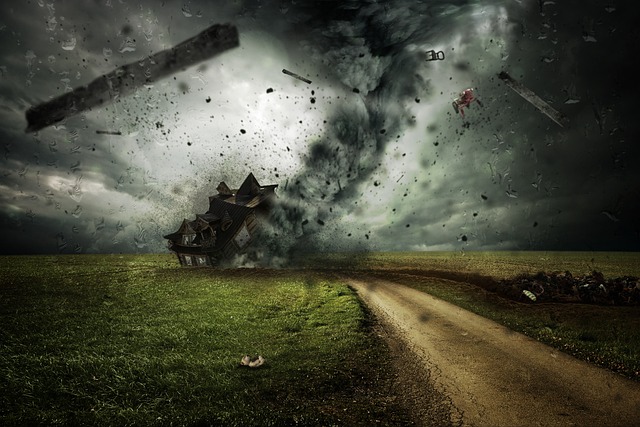To prepare for a tornado, you should first know the danger zones in your area. Establish an emergency plan and practise it with your family. Make sure you have enough supplies and shelters. Check regularly for weather warnings and be prepared to act quickly if needed.
General information about tornadoes
General information about tornadoes Before we get into specific protective measures, it is useful to first familiarise ourselves with some basic information about tornadoes. A tornado is a violent windstorm that forms from a thundercloud and can leave a trail of destruction on the ground. Tornadoes usually occur in spring and summer when warm and moist air masses meet cold and dry air. They are most common in the USA, but can also occur in Europe. Most tornadoes are relatively small and weak and cause only limited damage. However, there are also F5 tornadoes that can reach wind speeds of more than 400 km/h and destroy entire towns. It is therefore important to prepare for a tornado in order to be able to react quickly and safely in an emergency.
How can you prepare for a tornado?
Tornadoes are among the most dangerous natural disasters and can cause devastating damage in seconds. To prepare for a tornado, it is important to take action early. One of the most important protective measures for your home or building is to install a storm shelter, such as a tornado shelter or reinforced garage. If this is not possible, seek out an interior room in your home, such as a basement or bathroom without windows. Avoid rooms with large glass areas and stay away from exterior walls as well as skylights. It is also advisable to inform your family and neighbours about the dangers of tornadoes and make an emergency plan. Make sure everyone knows where the nearest shelter is and how to get there. In addition, have an emergency kit on hand that includes water, food, clothing and medicine. You should also have battery-powered radios and torches available in case of a power cut. By preparing early, you can protect your life and that of your family and minimise potential damage.
Protective measures for your house/building
Protective measures for your home/building To protect your home or building from a tornado, there are several measures you can take. First, you should make sure that all windows and doors are tightly closed. If possible, you should also install shutters or screens to prevent debris from entering. Another option is to install reinforced roof and wall coverings and bracing on the walls. It is also important to establish a safe zone inside the house or building. Locate a room inside the building that has no windows and is close to the ground floor. A basement or garage often offers the best protection. Make sure this room is equipped with emergency equipment such as water, food and first aid kits. Another important protective measure is to prepare an emergency plan for your family or staff. This plan should include detailed instructions on what to do in the event of a tornado and where the safe zone is located. It is also important to conduct regular emergency drills to make sure everyone knows what to do. By taking these protective measures, you can ensure that your home or building is as protected as possible from a tornado and that your family or employees are safe in the event of an emergency. Here is an helpful article for the cost of a tornado shelter.
What to do if you are outside?
If you are outside and a tornado hits, it can quickly become dangerous. Therefore, it is important that you seek shelter immediately. Try to get inside a building or seek shelter in a deep ditch or depression. Avoid trees, electricity pylons and other tall objects that could fall over. Lie flat on the ground and cover your head with your hands. If you are travelling by car, stop and also seek shelter in a building or depression. Avoid staying under bridges or overpasses as they may collapse. If there is no shelter nearby, park the car on the side of the road and do not leave the vehicle. Remain seated in the car and fasten your seat belt. Lower your head below the window line and cover it with your hands. If the tornado has passed, stay in your shelter for a while and wait for further instructions or information.
What precautions do you need to take in the event of a power outage?
When a tornado occurs, power outages can happen quickly. It is important to prepare and take precautions so that you are not helpless in the event of a power outage. One option is to have an emergency power supply such as a generator or an uninterruptible power supply (UPS) ready. Keeping batteries and torches on hand and charging mobile devices can also help to bridge the power cut. In addition, you should avoid using electrical appliances during the storm and disconnect them from the mains in the event of a power cut. Also make sure that your food supplies do not spoil and only open the refrigerator in an emergency. If the power outage lasts longer, you should prepare water and food supplies as well as find out about alternative heating options. Being well prepared for a power cut can help you to act better in an emergency situation.
What emergency kits should you have on hand?
To be prepared for a tornado, it is important that you have some emergency kits on hand. These should always be handy and contain all the important utensils you will need in an emergency. A first aid kit should definitely be part of your kit, as injuries unfortunately often occur during a tornado. A torch with spare batteries as well as a battery-powered radio should also not be missing from any emergency kit. If there is a power outage, this will help you stay informed and know what is happening around you. In addition, you should also stock enough water and non-perishable food to last you for several days in case of an emergency. Don’t forget to think about your pets too and provide food and water accordingly. If you need to take medication regularly, this should also be part of your kit. Make sure they have a long enough shelf life and replace them in good time if necessary. With these precautions, you are well prepared to survive a tornado unscathed.
How can you protect your family and neighbours?
In order to be optimally prepared for a tornado, you should not only pay attention to your own safety, but also that of your family and neighbours. For example, you can build up a network in your neighbourhood and take protective measures together. Consider in advance who in your neighbourhood might need help, such as elderly or sick people. Sharing information and experiences can also help you to better prepare for a tornado and to be able to react more quickly in an emergency. Also, plan ahead for emergency shelter in case your home is no longer safe. It is also important to inform your family about the dangers of a tornado and show them how to behave during a storm. This way, you can help ensure that your family and neighbours are well protected and can act quickly in the event of an emergency.
How do I prepare to deal with the media after a tornado?
After a tornado, it is important to deal with the media as well. You should prepare for journalists and camera crews to show up to report on the impact of the tornado. It is advisable to prepare a list of important information and contacts in advance that you can pass on to media representatives. This includes, for example, damage reports, contact information for insurance companies or emergency services, and any evacuation procedures. If you are not willing to give interviews or be filmed, you should politely tell the media representatives. It is important to note that the media can help get important information out to the public quickly and thus assist in restoring normality. However, it is also important to ensure that your privacy is respected and that no unwanted recordings or interviews take place. By being well prepared to deal with the media after a tornado, you can ensure that important information is disseminated quickly and your privacy is respected.
Conclusion: How best to prepare for a tornado
In order to best prepare for a tornado, it is important to take various protective measures in advance. These include, for example, installing reinforced windows and doors and putting protective screens on windows. Having a safe room inside the house or building can also be lifesaving in case of an emergency. If you are outside, seek shelter in a building or shallow ground depression as soon as possible. Be sure to avoid trees and power poles as well as bridges and overpasses. In the event of a power outage, always have emergency lighting on hand and make sure your electronic devices are fully charged. A well-packed emergency kit can also help keep you able to act quickly in an emergency situation. Don’t forget to also inform your family and neighbours about the risks and protective measures so that everyone knows what to do in an emergency. Finally, be prepared for how you will handle media enquiries after a tornado. By following these tips and exercising caution, you can best prepare for a tornado and save lives in the event of an emergency.

